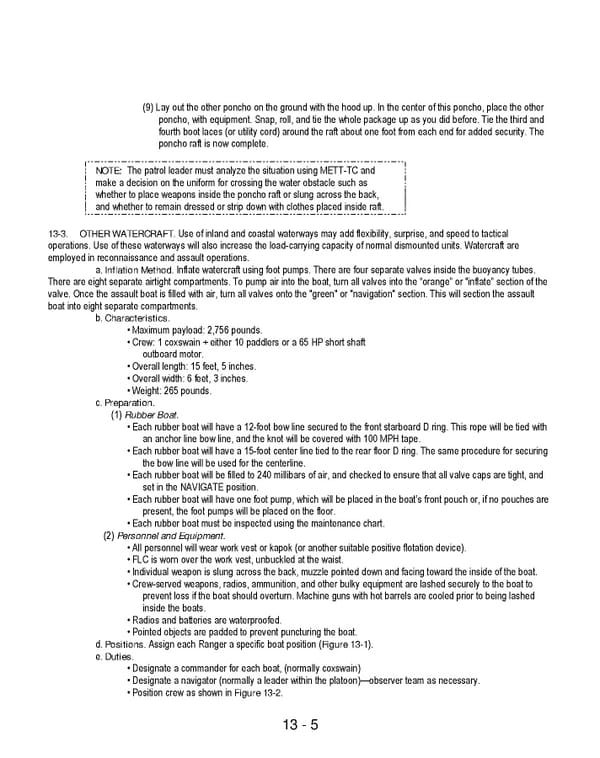13 - 5 (9) Lay out the other poncho on the ground with the hood up. In the center of this poncho, place the other poncho, with equipment. Snap, roll, and tie the whole package up as you did before. Tie the third and fourth boot laces (or utility cord) around the raft about one foot from each end for added security. The poncho raft is now complete. NOTE: The patrol leader must analyze the situation using METT-TC and make a decision on the uniform for crossing the water obstacle such as whether to place weapons inside the poncho raft or slung across the back, and whether to remain dressed or strip down with clothes placed inside raft. 13-3. OTHER WATERCRAFT. Use of inland and coastal waterways may add flexibility, surprise, and speed to tactical operations. Use of these waterways will also increase the load-carrying capacity of normal dismounted units. Watercraft are employed in reconnaissance and assault operations. a. Inflation Method. Inflate watercraft using foot pumps. There are four separate valves inside the buoyancy tubes. There are eight separate airtight compartments. To pump air into the boat, turn all valves into the “orange” or "inflate” section of the valve. Once the assault boat is filled with air, turn all valves onto the "green" or "navigation" section. This will section the assault boat into eight separate compartments. b. Characteristics. • Maximum payload: 2,756 pounds. • Crew: 1 coxswain + either 10 paddlers or a 65 HP short shaft outboard motor. • Overall length: 15 feet, 5 inches. • Overall width: 6 feet, 3 inches. • Weight: 265 pounds. c. Preparation. (1) Rubber Boat. • Each rubber boat will have a 12-foot bow line secured to the front starboard D ring. This rope will be tied with an anchor line bow line, and the knot will be covered with 100 MPH tape. • Each rubber boat will have a 15-foot center line tied to the rear floor D ring. The same procedure for securing the bow line will be used for the centerline. • Each rubber boat will be filled to 240 millibars of air, and checked to ensure that all valve caps are tight, and set in the NAVIGATE position. • Each rubber boat will have one foot pump, which will be placed in the boat’s front pouch or, if no pouches are present, the foot pumps will be placed on the floor. • Each rubber boat must be inspected using the maintenance chart. (2) Personnel and Equipment. • All personnel will wear work vest or kapok (or another suitable positive flotation device). • FLC is worn over the work vest, unbuckled at the waist. • Individual weapon is slung across the back, muzzle pointed down and facing toward the inside of the boat. • Crew-served weapons, radios, ammunition, and other bulky equipment are lashed securely to the boat to prevent loss if the boat should overturn. Machine guns with hot barrels are cooled prior to being lashed inside the boats. • Radios and batteries are waterproofed. • Pointed objects are padded to prevent puncturing the boat. d. Positions. Assign each Ranger a specific boat position (Figure 13-1). e. Duties. • Designate a commander for each boat, (normally coxswain) • Designate a navigator (normally a leader within the platoon)—observer team as necessary. • Position crew as shown in Figure 13-2.
 Ranger Handbook Page 240 Page 242
Ranger Handbook Page 240 Page 242